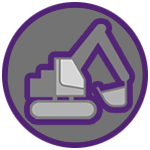Safety Tips for the Workplace
1. Use tools, equipment and machinery properly
Proper use of tools and machinery can prevent injuries. Only operate machines you are trained or certified to use and ensure that they are cleaned and maintained regularly. You should always use machines and equipment for their intended purposes. Use equipment such as a wheelbarrow or a forklift to help you lift and move heavy items to prevent straining or injuring yourself.
2. Report any unsafe conditions
Fix any unsafe conditions or workplace hazards as soon as you notice them. If it is dangerous for you to remove the risk, notify a supervisor right away.
3. Wear all necessary safety gear
Always wear the necessary safety equipment. The proper safety gear in your workplace could be reflective gear, fire-retardant clothing, industrial workwear or something as simple as nonslip shoes. Be sure to always wear a breathing mask if your space has debris or dust, or if you have to deal with toxic or dangerous chemicals or fumes.
4. Keep your workplace clear from clutter
Having a clean workspace will positively impact your job satisfaction and keep you and your coworkers free from danger. You could trip and fall over scattered objects and they could hide another hazard you cannot see.
5. Stay hydrated
Drink enough water to remain alert and avoid dehydration. Even in the winter, it is essential to stay hydrated with water and warm liquids to prevent lightheadedness and lack of focus.
6. Practice good posture when sitting or lifting
Use ergonomic desks and keyboards to avoid straining your wrists and arms. Sit up straight, keep your shoulders in line with your hips and lift with your legs when you are moving objects. Poor posture can cause strain on your back, neck and shoulders, which can lead to serious injury.
7. Take regular breaks
Look away from your computer screen regularly to avoid eye strain. Taking regular breaks allows your body an opportunity to rest from the tasks you are doing. When you return, you will be more focused and have a higher level of concentration.
8. Be aware of your surroundings
- Being aware of your surroundings is paramount to avoiding workplace injuries. Here are some things to be aware of in your environment:
- Look for spills or items on the floor that could be tripped over.
- Note the appropriate safety equipment and gear for each task you are doing.
- Choose mechanical aids such as a forklift or wheelbarrow to help lift items and encourage others to do the same.
- Keep emergency exits clear and uncluttered so they are accessible in the event of an emergency.
- Use tools and machines properly to avoid injury and encourage other workers to do the same.
- Label hazardous areas and materials with appropriate signage.
- Know where the first aid kits are and which staff members are trained to administer first aid if an injury occurs.
- Know of the emergency procedures in the event of a fire, flood or earthquake.
- Only use secure, steady ladders and never use boxes or anything else as an improvised ladder.
- Test railings first before using them to make sure they are secured properly.
9. Never take shortcuts
Procedures exist to keep workers safe. Though skipping a step or not wearing safety gear may save you time, it isn’t worth getting injured over. Use every tool and machine according to the instructions.
10. Remain aware of new safety procedures



















